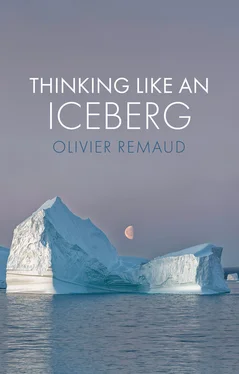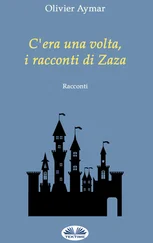Another argument recurs in this interpretive framework: titanic forms bear the imprint of a higher principle. Kane described the Arctic as ‘a landscape such as Milton or Dante might imagine – inorganic, desolate, mysterious’. He was careful to add: ‘I have come down from deck with the feelings of a man who has looked upon a world unfinished by the hand of its Creator.’ The spectacular appearance of the icebergs is a reminder of the humble condition of humans. The drifting boulder is ‘one of God’s own buildings, preaching its lessons of humility to the miniature structures of man.’ 6The theme is an old one. Long before the beginnings of polar exploration, the iceberg was seen as a work of providence.
We are in Ireland, in the sixth century.
A monk tells another monk about his voyage in a stone trough, as in the legends of the Breton saints. He evokes a remote, isolated and magical island. All shrouded in fog, it is hidden from inquisitive eyes and unvisited by storms. On this land, nothing happens as elsewhere: nature is luxuriant, time slows down, no one feels any material need. Faced with so many marvels recounted by his own godson, Mernoc the monk, Brendan de Clonfert decides to make the same journey. After months of meticulous preparations, he and his fourteen companions embark on a small boat made of wood and leather. They set off towards the Northwest in search of paradise.
In their frail curach , the pilgrims huddle around the single mast. The voyage is full of hazards and miracles. They come across birds singing divine hymns and drink sleeping potions. They inadvertently cook meat on the backs of gigantic dormant fish and are attacked by sea monsters.
One day, a crystal pillar appears. It seems very close, yet it takes them three days to reach it. When Brendan looks up, he cannot see the top of the transparent pillar, which is lost in the sky. Gradually, other pillars appear. At the very top, a huge platter sits on four square legs. A sheet with thick, undulating mesh as far as the eye can see envelops it. The monks think they are looking at an altar and a tapestry. They tell themselves that this is the Lord’s work.
Brendan notices a gap where their boat could slip through. He orders his companions to lower the sail and mast. They gently row into the crevice and find themselves inside a huge reticular mass. Corridors stretch out endlessly. The colours in the walls are shimmering, changing from green to blue. Shades of silver sparkle. Their fingertips graze a material that feels like marble. At the bottom of the water, they see the ground on which the diaphanous block rests. The sun is reflected in it. There is bright light, inside and out. Brendan takes measurements. For four days they calculate the dimensions of the sides. The whole thing is several kilometres and as long as it is wide. The pilgrims can’t believe it.
The next day, they discover a flared bowl and a golden plate adorning the edge of one of the pillars. Brendan is not surprised. He places the chalice and paten before him and begins to celebrate the Eucharist. When the ceremony is over, he and his companions hoist the mast and sail. They take hold of the oars and set off. On their return journey, they are carried by favourable winds that bring them home without incident. 7
Brendan’s epic was copied hundreds of times between the ninth and the thirteenth century, a real bestseller. Today’s commentators believe that the travelling monks saw an iceberg floating off the coast of Iceland. They would have entered the straits where icebergs calve off the coastal glaciers of Greenland.
At the time Church and Noble were travelling, icebergs were, in the European imagination, sometimes the ancestors of a geological age, sometimes creatures in the service of a sacred history. In both cases, they are icons of the sublime. Our narrator and the painter are not the only ones to see ‘floating mountains’ in the ocean, or cathedrals, ruins of lost cities, winding avenues, and sometimes even the face of the Creator. When ships are icebound, there is plenty of time to observe the landscape, and at such moments the romantic mind opens its toolbox and chooses the most expressive aides.
Thomas M’Keevor served in 1812 as the physician for the Selkirk settlers in the Red River Colony in Canada. In a short travelogue, he expresses his fascination for the icebergs adorning Hudson Bay. Some of them, he wrote,
bear a very close resemblance to an ancient abbey with arched doors and windows, and all the rich embroidery of the Gothic style of architecture; while others assume the appearance of a Grecian temple supported by round massive columns of an azure hue, which at a distance looked like the purest mountain granite . . . The spray of the ocean, which dashes against these mountains, freezes into an infinite variety of forms and gives to the spectator ideal towers, streets, churches, steeples, and in fact every shape which the most romantic imagination could picture to itself. 8
This description is already in the style of Louis Legrand Noble! It shows that icebergs have been perceived, in the Western world, as a real production in the amphitheatre of the most unbridled reveries. We all have the faculty of imagination in common. The five Labrador Inuit shown around London by Captain George Cartwright in 1772 thought St Paul’s Cathedral was a mountain. They mistook the bridge over the Thames for some kind of stone structure. Those from Avannaa who landed with the explorer Robert Peary in New York in 1887 were struck by the resemblance of the first skyscrapers in Manhattan to icebergs. Each, in its own way, mixes ‘the natural and the architectural’. 9The metaphorical gaze, transposing one environment into another, is no less a characteristic of the Romantic spirit. Western travellers are wordsmiths. They make sentences. They chase the wildest of associations and spend their time imagining something other than what they see. They enter imaginary palaces vicariously and experience feelings of grandeur. It is as if they have promised to bring back postcards from these strange worlds.
In the wake of Franklin’s tragedy, the far North and then the far South became obsessions that ran throughout the second half of the nineteenth century until the 1920s. Everyone had unique experiences in these icy latitudes. They are sometimes exhilarating, but always exhausting. And the closer one gets to the poles, the more dramatic they become.
Before embarkation, the explorers are full of enthusiasm. They dream of sea ice and icebergs. Roald Amundsen decided to follow in Sir John Franklin’s footsteps because he had spent his nights, as a child, trying to find the Northwest Passage. Every morning, on awakening, he steeled himself to endure any hardship. His colleague Ernest Henry Shackleton tells of his dream in which he sees himself, at the age of twenty-two, on the deck of a ship in the Atlantic, his eyes in thrall to the snow and ice. His sole aim is to reach one of the planetary poles. 10Frank Worsley imagines that he is sailing among drifting icebergs on Burlington Street, London, where Shackleton had set up an office to audition candidates for the position of captain of the Endurance . Next thing, he was recruited.
These desires to conquer knew no bounds. But the enthusiasm of initial dreams does not last. Reality is a quite different thing. In his 2012 Atlas of an Anxious Man , the Austrian writer Christoph Ransmayr recounts how he discovered the Arctic territories twenty years after writing the novel The Terrors of Ice and Darkness . Yet it is difficult to find a better description of the torments endured by polar explorers.
The text combines the records of the Austro-Hungarian Imperial and Royal Arctic Expedition of 1872–1874 with the fictional tribulations of Josef Mazzini, a young man who retraces the journey many years later. Ransmayr relies heavily on the diary of Julius von Payer, a cartographer and a first-class ensign who was also the land-based commander of the expedition that set out to find the Northeast Passage.
Читать дальше












